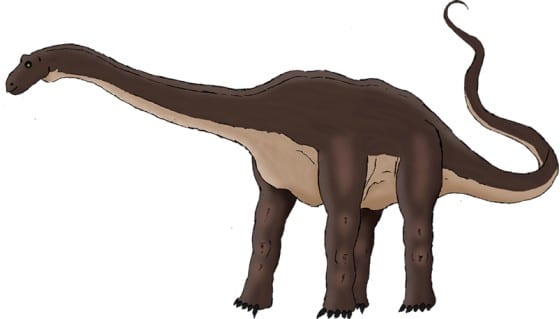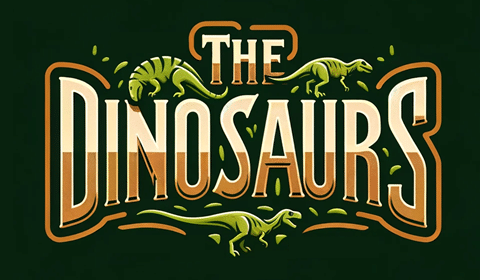Amazonsaurus maranhensis was an herbivore sauropod, living during the Early Cretaceous period. Its name is derived from the Amazon region of Brazil where its fossils were first discovered and paints a vivid picture of this dinosaur’s origins. This fascinating creature, with its long neck and tail, is a testament to the diverse and vibrant life that once thrived on our planet.
Key Facts
| Keyword | Fact |
|---|---|
| Amazonsaurus pronunciation | am-ah-zon-saw-ruhs |
| Meaning of name | Amazon dinosaur |
| Group | Sauropod |
| Type Species | Amazonsaurus maranhensis |
| Diet | Herbivore |
| When it Lived | 122.46 to 105.3 MYA |
| Period | Early Cretaceous |
| Epoch | Late/Upper Aptian to Middle Albian |
| Length | 40.0 ft |
| Height | 8.2 ft |
| Weight | 5.5 tons |
| Mobility | Quadrupedal |
| First Discovery | 1993 by Ismar de Souza Carvalho, Leonardo dos Santos Avilla and Leonardo Salgado |
| Location of first find | Itapecuru Formation (Maranhão), Brazil |
| First Described by | 2003 by Ismar de Souza Carvalho, Leonardo dos Santos Avilla, Leonardo Salgado |
| Holotype | MN 4558-V; UFRJ-DG 58-R/9 |
Amazonsaurus Origins, Taxonomy and Timeline

Amazonsaurus‘ name is a combination of the Amazon region of Brazil where its fossils were first discovered and ‘sauros’, the Greek word for lizard.
Its type species name A. maranhensis is inspired by the name of the Brasilian state Maranhão where it was found.
A member of the sauropod group, Amazonsaurus is part of the Rebbachisauridae family.
It lived during the Early Cretaceous period, specifically from the Late Aptian to Middle Albian epochs. This dates it existance to between 122.46 and 105.3 million years ago, a time when dinosaurs were the dominant terrestrial vertebrates.
Fossil Evidence
The first discovery of Amazonsaurus was made in 1993 in the Itapecuru Formation in Maranhão, Brazil. It was the first genus of dinosaur to have been named from the Amazon Basin. However, the dinosaur was not described until 2003 by Carvalho, Avilla, and Salgado.
The fossils of the Amazonsaurus so far include back and tail vertebrae, ribs, and fragments of the pelvis. These remains are the only dinosaur fossils identifiable at the generic level from the Itapecuru Formation, which dates back to the Aptian through Albian epochs of the Early Cretaceous Period.
These fossils were recovered in sediments which are interpreted by geologists as floodplain deposits near a river delta. Therefore, this suggests that the Amazonsaurus lived in a lush, fertile environment with abundant vegetation that it would have fed on.
Amazonsaurus Size and Description
Amazonsaurus was a diplodocoid sauropod, characterized by its long neck and tail. Its body shape was typical of sauropods, with a large, barrel-shaped body supported by four sturdy legs. Its tail, long and flexible, may have served as a counterbalance for its long neck and could also have been used for defense against predators.
It moved on all four legs, a characteristic common among sauropods. Its speed is unknown, but like most sauropods, it was likely a slow-moving creature due to its large size making quick movements challenging.
Size and Weight of Type Species
It was probably not more than 40 feet long. In terms of weight, Gregory S. Paul estimated in 2010 that the Amazonsaurus could have weighed up to 12.000 lbs (6 US tons). Consequently, this makes the Amazonsaurus a relatively small sauropod, as some members of this group were among the largest animals to have ever lived.

The Amazonsaurus in its Natural Habitat and Environment
South America at this time would have been a lush, fertile environment abundant in the vegetation that it would have fed on. This is supported by the fact that the fossils were recovered in sediments interpreted as floodplain deposits near a river delta.
The climate during the Early Cretaceous period was warm, and this region was dominated by shallow seas and vast river systems. The vegetation during this time was diverse, with ferns, cycads, and the first flowering plants beginning to appear.
As an herbivorous dinosaur, it would have fed on the abundant vegetation in its environment. Its long neck would have allowed it to reach vegetation that other herbivores couldn’t, reducing its competition when it came to finding food. It’s likely that Amazonsaurus was a slow-moving creature, its large size making quick movements challenging.
This, combined with its herbivorous diet, suggests that Amazonsaurus was a grazer that spent much of its time feeding on low-lying vegetation. Similar to other large herbivores, this dinosaur would have had a significant impact on its environment by shaping the landscape through its feeding habits and potentially influencing the distribution of plant species.
Interesting Points about the Amazonsaurus
- It is the first named dinosaur genus from the Amazon Basin, marking an important event in the region’s rich paleontological history.
- Despite being a sauropod, it was relatively small compared to other members of its group. It was likely not more than 12 meters (40 ft) long and could have weighed up to 5000 kg (5 tons).
- It had a long neck and a long, flexible tail. These features not only allowed it to reach vegetation that other herbivores couldn’t, but also served as a defense mechanism against predators.
- The discovery in the Itapecuru Formation in Maranhão, Brazil, marked a significant milestone in paleontology. The fossils found in 1993 are the only dinosaur fossils identifiable at the generic level from this formation.
- It lived in a lush, fertile environment, abundant in the vegetation that it would have fed on. This is suggested by the fact that the fossils were recovered in sediments interpreted as floodplain deposits near a river delta.
Contemporary Dinosaurs
Amazonsaurus shared this fertile environment with an exciting range of South American dinosaurs. These fellow dinosaurs each highlighted the similarities and differences of adaptations in this part of the world when compared to the Amazonsaurus.
Consider the Tapuiasaurus, a dinosaur that—while smaller than the Amazonsaurus—was no less significant in the prehistoric landscape. The potential interactions between these two herbivores paint a vivid picture of coexistence. They may have grazed side by side, their diets possibly overlapping, leading to a subtle competition for the same resources. However, their size difference might have led them to different feeding heights, allowing them to coexist without direct competition.
On the other hand, the presence of carnivores such as Spinosaurus and Santanaraptor would have added a different dynamic. The Spinosaurus was significantly larger than Amazonsaurus. It might have posed a threat and a constant reminder of the predator-prey relationship in this ancient world. The smaller Santanaraptor, while not a direct threat to a fully grown Amazonsaurus, might have targeted the young or weak.
Frequently Asked Questions
It lived during the Early Cretaceous period. More specifically from the Late Aptian to Middle Albian epochs, between 122.46 and 105.3 million years ago.
The first fossils were discovered in the Itapecuru Formation in Maranhão, Brazil.
It was an herbivore, feeding on the lush vegetation of its environment.
It was likely not more than 40 ft long and could have weighed up to 5 tons.
The name translates to “Amazon lizard”. The “Amazon” part of its name is derived from the Amazon region of Brazil where its fossils were first discovered.
Sources
Please note that this article is based on various sources, drawing on scientific research, fossil evidence, and expert analysis. The aim is to provide a comprehensive and accurate overview of the Amazonsaurus. However, please be aware that our understanding of dinosaurs and their world is constantly evolving as new discoveries are made.
Article last fact checked: Joey Arboleda, 12-27-2024
Featured Image Credit: DarkWerewolf, CC BY-SA 4.0 https://creativecommons.org/licenses/by-sa/4.0, via Wikimedia Commons
